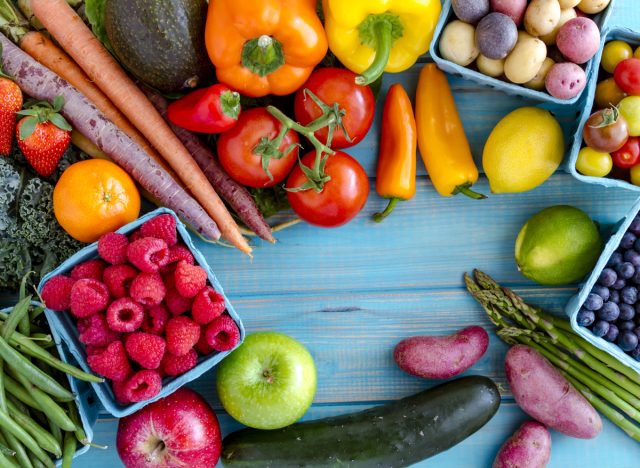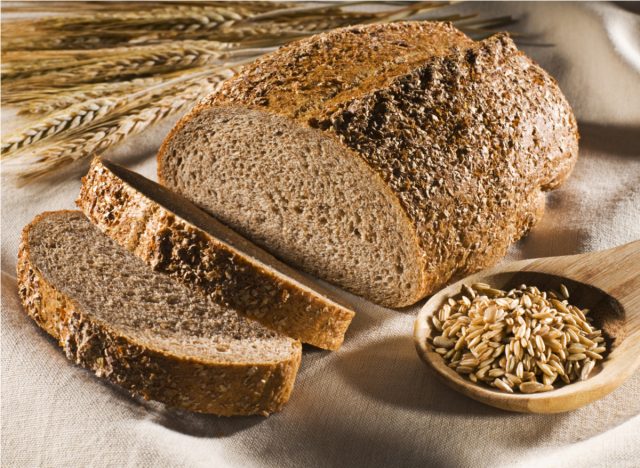As the seasons change, there’s no better time to change your habits, and if you’re looking to shed some pounds, then more specifically, your eating habits. After all, studies have shown that your diet is a crucial component of weight loss, and it’s extremely difficult to reach your goals with just exercise alone.
The good news is that changing your eating habits doesn’t have to mean missing out on the foods you love. Rather, the idea is to focus on the healthiest choices as often as possible, to the point where reaching for a piece of fruit rather than a pastry feels second nature.
“Research shows that around 40% of our behaviors are habit-driven, not decision-driven,” says Kitty Broihier, RD, registered dietitian, creator of the Eating Habits Lab, and owner of NutriComm Consulting. “When it comes to weight loss, it’s the repeated actions we make daily that can make or break our success. Will power only gets you a little way toward your goal before it wears out. Your healthy eating habits are what will carry you to the weight loss finish line—and you won’t even have to spend precious brainpower thinking about them.”
With that in mind, adopt these dietitian-approved eating habits for faster weight loss this fall. Then for more healthy eating tips check out 15 Healthiest Chili Recipes for Weight Loss.
Stick to a Schedule
“When you don’t have an eating schedule, you’re more likely to skip meals, overeat at other meals, snack mindlessly, and get into other habits that can compromise your weight loss efforts,” says Blanca Garcia, RDN, a nutrition specialist at Health Canal.
That’s why she advises choosing specific times to eat your meals. For example, you might decide to eat breakfast every day at 8 a.m., lunch at 12 p.m., a snack at 3 p.m, dinner at 6 p.m, and a snack at 8:30 p.m. The idea is to create a pattern that works for your lifestyle.
Depending on your needs, that may mean smaller, more frequent meals, or you may prefer larger and less frequent ones with small fasts in between dinner and breakfast the next day. The point is to create some structure so your body knows when to expect sustenance.
“This benefits your weight loss journey in two ways,” says Garcia. “First, if you know when you will eat you can plan accordingly by prepping meals ahead of time and reducing last-minute drive-through runs for calorie-dense foods. Second, as your body gets used to those set times, your hunger cues turn on and can alert you that it’s time to eat, reducing the need to overdo it due to ignoring or not even receiving those cues.”
Eat More Seafood
Seafood is one of your safest bets for weight loss, not only because it’s so high in protein, but also because it’s packed with omega-3 fatty acids, which studies have shown can help you to feel fuller for longer.
Rima Kleiner, RD, registered dietitian and the blogger behind Dish On Fish, says all seafood can be beneficial for weight loss. However, according to Kleiner, salmon is particularly high in satiating omega-3s, and shrimp is not only low in calories but also stimulates the production of a hunger-reducing hormone called CCK.
Kleiner recommends aiming to incorporate seafood into your diet at least two to three times a week.
“When it comes to weight loss and health, the most important thing is choosing seafood that’s healthfully prepared and cooked,” she says. “Say no to fried fish, and ditch the dishes with calorie-dense sauces. Instead, opt for baked, sautéed, steamed, grilled, or boiled shrimp with sauces and dips on the side for the biggest nutrient bang.”
Add 3 Servings of Veggies and Fruits

There are a lot of benefits to eating more vegetables and fruit—but in regards to weight loss specifically, these foods are low in calories and super high in filling fiber. For this reason, Dana Ellis Hunnes, RD, a senior clinical dietitian at UCLA medical center and author of Recipe For Survival, recommends incorporating at least three servings of veggies and fruit into your diet every day.
Some examples of what that might look like are a chopped apple in oatmeal at breakfast, one cup of mixed green salad at lunch, and a half cup of steamed broccoli with chicken at dinner. Another example could be one cup of sliced tomatoes in an omelet at breakfast, one banana in a mid-afternoon smoothie, and a half cup of roasted asparagus with fish at dinner.
“Fruits and vegetables can replace many of the less healthy, high-calorie foods you might eat in a day, thereby lowering your calorie intake and increasing weight loss,” adds Hunnes.
Swap Some of Your Animal Proteins for Plant-Based Ones
While meat and dairy may be high in protein, many animal products are also high in saturated fat. This is why Garcia advises swapping out animal-based proteins for plant-based proteins, like chickpeas, lentils, beans, tofu, quinoa, nuts, and seeds, whenever you can. As an added bonus, plant-based proteins tend to be much higher in fiber as well.
“Fiber keeps you full longer due to how long it takes to pass through the digestive tract,” adds Diana Gariglio-Clelland, RD, a registered dietitian with Soylent.
If you currently eat animal protein every day, aim to make this swap at least 2-3 days a week. Still struggling to cut back on meat? Jesse Feser, RD, a registered dietitian with My Crohns and Colitis Team, suggests switching from higher-fat red meats and processed meats to lean proteins like turkey, chicken, fish, and eggs.
Substitute Refined Carbs for Whole Grains

Another super smart swap to make, according to Garcia, is opting for whole grain products over refined grains. Examples of some easy substitutions to try would be 100% whole-wheat bread instead of white bread, brown rice or spelt pasta instead of white pasta, quinoa or farro instead of white rice, and oatmeal instead of cereal made with white flour.
Whole grains are not only packed with more nutrients than their refined counterparts, but they also contain more fiber. Of course, that means they’ll keep your hunger pangs at bay for much longer, which may promote weight loss by preventing you from snacking too much in between meals.
In fact, a 2008 review in Public Health Nutrition found that eating three servings of whole grains daily was linked to lower body mass index.
Practice Mindful Eating
When you’re not present while you’re eating, you can not only miss out on the joyful experience of enjoying your food, but you also may miss the signals that you’re getting full, causing you to accidentally overeat. This is why Catherine Gervacio, RD, a registered dietitian and contributor at Living Fit, recommends eating mindfully. This means taking your time while you’re eating to really tune into what your body is telling you.
Some tips for mindful eating are giving yourself at least 20 minutes to enjoy a meal so you can recognize hunger and fullness cues, eliminating distractions like TV during meal times, planning meals with others because conversation encourages you to take time while eating, and pausing in between bites of food to check in with your body and ask, “do I need more?” or “have I had enough?”

